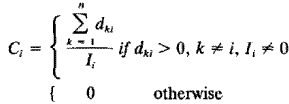Lin Centrality
Definition
Nan Lin [LIN, N. 1976] tried to repair the definition of closeness for graphs with infinite distances by weighting
closeness using the square of the number of coreachable nodes; his definition for the centrality of a
node x with a nonempty coreachable set is:

The rationale behind this definition is the following: first, we consider closeness not the inverse of a sum of distances, but rather the inverse of the average distance, which entails a first multiplication by the number of coreachable nodes. This change normalizes closeness across the graph. Now, however, we want nodes with a larger coreachable set to be more important, given that the average distance is the same, so we multiply again by the number of coreachable nodes. Nodes with an empty coreachable set have centrality 1 by definition [BOLDI, P. 2014].
Lin (1976) measures centrality as the average number of steps (dki) involved in organization i's linkage with all other organizations, directly or indirectly naming them. Lin (1976) noted that in matrix notation, all of the organizations will appear in the rows and the columns of the matrix. The convention is to use the rows to identify the naming organizations and the columns for the named organizations. There can be no loops (self-nominations). A zero is assigned to all diagonal cells in the matrix. In the off-diagonal cells, a value of 1 represents an ongoing tie, while a zero denotes no direct tie. The row totals represent the number of organizations agency i named as having direct linkages. The column total represents the number of organizations that named agency k as a direct link. Lin noted that "the sum of each row indicates the frequency of the nominations each organization has made" (Lin, 1976, p. 334). However, these row totals reflect only direct ties, and further matrix manipulation needs to be conducted if indirect linkages are to be considered. In order to calculate centrality measures, indirect linkages need to be included in the calculation. The smaller the value of C, the more central organization i in the network (Lin, 1976, p. 345). Ii represents the influence domain of an organization and is defined as the extent to which the opinion of an organization is sought both directly and indirectly.
[HOFFMAN, A. N., 1990]


The rationale behind this definition is the following: first, we consider closeness not the inverse of a sum of distances, but rather the inverse of the average distance, which entails a first multiplication by the number of coreachable nodes. This change normalizes closeness across the graph. Now, however, we want nodes with a larger coreachable set to be more important, given that the average distance is the same, so we multiply again by the number of coreachable nodes. Nodes with an empty coreachable set have centrality 1 by definition [BOLDI, P. 2014].
Lin (1976) measures centrality as the average number of steps (dki) involved in organization i's linkage with all other organizations, directly or indirectly naming them. Lin (1976) noted that in matrix notation, all of the organizations will appear in the rows and the columns of the matrix. The convention is to use the rows to identify the naming organizations and the columns for the named organizations. There can be no loops (self-nominations). A zero is assigned to all diagonal cells in the matrix. In the off-diagonal cells, a value of 1 represents an ongoing tie, while a zero denotes no direct tie. The row totals represent the number of organizations agency i named as having direct linkages. The column total represents the number of organizations that named agency k as a direct link. Lin noted that "the sum of each row indicates the frequency of the nominations each organization has made" (Lin, 1976, p. 334). However, these row totals reflect only direct ties, and further matrix manipulation needs to be conducted if indirect linkages are to be considered. In order to calculate centrality measures, indirect linkages need to be included in the calculation. The smaller the value of C, the more central organization i in the network (Lin, 1976, p. 345). Ii represents the influence domain of an organization and is defined as the extent to which the opinion of an organization is sought both directly and indirectly.
[HOFFMAN, A. N., 1990]

Lin centrality:
Software
References
- BOLDI, P. & VIGNA, S. 2014. Axioms for centrality. Internet Mathematics, 00-00.
DOI: 10.1080/15427951.2013.865686


- BOLDI, P. & VIGNA, S. 2004. The webgraph framework I: compression techniques. Proceedings of the 13th international conference on World Wide Web. New York, NY, USA: ACM.
DOI: 10.1145/988672.988752


- HOFFMAN, A. N., STEARNS, T. M. & SHRADER, C. B. 1990. Structure, context, and centrality in interorganizational networks. Journal of Business Research, 20, 333-347.
- LIN, N. 1976. Foundations of social research, McGraw-Hill.
